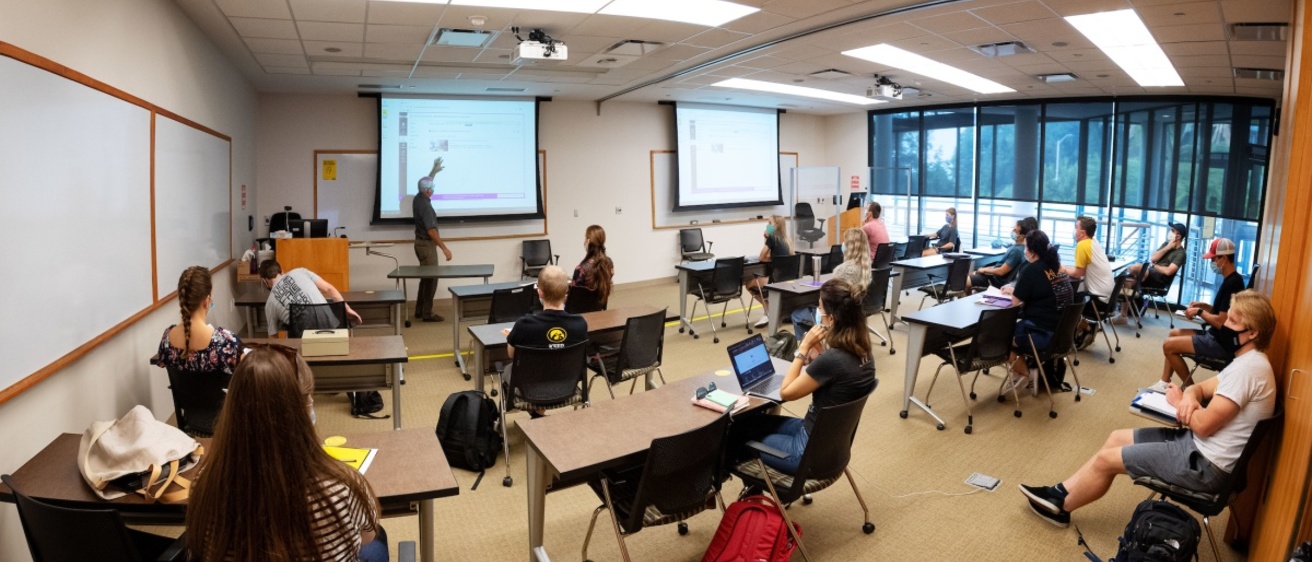
Breadcrumb
Making better introductions
The Hawkeye Introductory Course initiative targets high-enrollment courses that are especially difficult for students discovering the demands of college academics, aiming to identify challenges specific to each course and help more students succeed.
These introductory courses can be make-or-break moments for students. A new partnership aims to help instructors in these courses identify student needs, enhance course delivery, and help more students succeed.
“The same courses—chemistry, algebra, statistics, etc.—are challenging for institutions similar to us, too,” says Jamie Tanas, a course improvement coordinator with the Office of Teaching, Learning, and Technology. “We’re currently working with six courses in five departments.”
The goal: Identify challenges specific to each course and help more students succeed.
“We hope we can transform courses to improve student learning and instructor experience,” says Stephanie Preschel, director of academic success for Academic Support and Retention. “We’d like to see courses taught in ways that work well for everyone.”
New funding, renewed effort
Revenue from the university’s public-private utility partnership helps coordinate and expand resources that were already in place across campus. An institutional strategic plan work group focused on student success identified strengthening introductory courses as a top priority.
The project integrates services that were provided by units across the university into a cohesive whole. Academic Support and Retention provides coordination, supplemental instruction, and peer learning assistants. The Office of Teaching, Learning, and Technology brings its expertise in pedagogy, educational development, academic technology, and learning analytics.
The intro-course initiative emphasizes factors like format, structure, and materials. It’s especially focused on active learning—a challenge for big courses that tend to lean on lectures.
“We’re not looking for ‘best practices,’ because every course is different,” Tanas says.
“We’re focused on intentionally better practices. It’s a matter of starting with evidence-based strategies and continuing to measure.”
Student background and habits
To effectively plan and test practices, project leads and course instructors must answer two key questions: What do we know about our students and what’s working for them?
Demographic data can show, for example, percentages of first-generation or underrepresented students in a course. But other data go further: They can chart how many students are engaging with ICON, watching videos, or using eTexts.
Monitoring data on how the instructional changes impact student performance helps project leads assess progress toward goals, which include boosting outcomes for student populations who typically perform less well than peers.
“We’re trying to create more equitable learning experiences and close gaps,” Preschel says.
Tailored interventions
Preschel, Tanas, and colleagues see common issues across the courses they work with. High enrollment makes it hard to give individual students feedback. Large teaching teams are challenged to communicate and coordinate amongst themselves.
But there’s no one-size-fits-all solution to these problems. “Our approaches are tailored to every single course,” Tanas says.
Some courses integrate technologies like Top Hat to actively engage students during class.
Others adopt new teaching methods, including peer learning assistants who are trained to float and field questions during in-class activities.
“We hear from students how helpful it can be to turn to a peer,” Tanas says. “Some students say they’re intimidated by the thought of asking a question or making a mistake. Peers reduce that pressure.”
Project leads recognize that challenges and solutions can transcend individual courses.
“Some students have never really been taught how to learn,” Preschel notes. Intro-course instructors can weave information about mindset or metacognition into their material, but students also need ready access to additional supports.
Long-term project
The initiative joins other centrally supported efforts to merge technology and teaching practices into more effective courses. Leads emphasize that it’s a long-term proposition.
“Everyone involved knows this project won’t be complete in a semester,” says Tanas. “Since its inception, the Office of Teaching, Learning, and Technology has supported transformative teaching and learning at the UI, and we’re committed to engaging with that work for years to come."
Evidence suggests that course-improvement projects and related initiatives are gradually shifting academic culture at Iowa.
“We survey faculty and instructors and ask whether they talk to department colleagues about course design,” Preschel says. “More and more, they answer ‘yes.’”